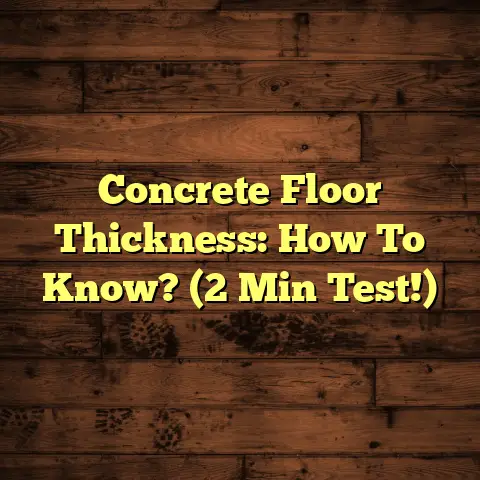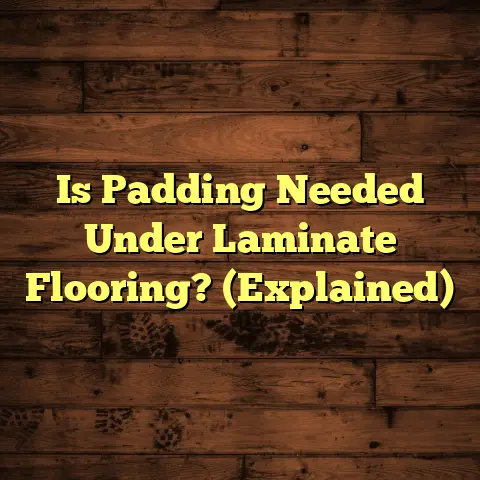Flooring Calculator: Measure Like A Pro! (7 Min Estimate!)
“Accurate measurements are the foundation of every successful flooring project. A small error can lead to significant costs and delays.” – Tom Silva, General Contractor, This Old House
Hey folks! Tom here, your friendly neighborhood flooring contractor. I’ve seen it all when it comes to flooring, and let me tell you, nothing is more important than getting your measurements right.
Trust me, I’ve witnessed firsthand the chaos that ensues when measurements are off. That’s why I’m diving deep into the world of flooring calculators today. They’re not just fancy tools; they’re your secret weapon for a flawless flooring project.
Section 1: Understanding the Importance
of Accurate Measurements
Why is accuracy so crucial? Well, imagine ordering too little material. You’re stuck waiting for more to arrive, delaying the whole project. On the flip side, ordering too much means wasted money and extra materials cluttering up your space. Nobody wants that!
Aesthetics are also a big deal. If your measurements are off, your flooring might not align properly, leading to uneven edges and a less-than-perfect finish. It’s like trying to fit a square peg in a round hole – frustrating and visually unappealing.
Let me share a quick story. I once worked on a kitchen remodel where the homeowner tried to estimate the flooring needs themselves. They underestimated by about 15 square feet. That doesn’t sound like much, right?
Wrong! It meant a week’s delay waiting for the extra tiles, and the dye lot was slightly different, resulting in a noticeable color variation in one corner. A costly and avoidable mistake.
Section 2: Overview of Flooring Calculators
So, what exactly is a flooring calculator? Simply put, it’s a tool designed to determine the amount of flooring material you need for a specific area.
Think of it as your digital assistant, taking the headache out of manual calculations. There are several types available:
-
Online Calculators: These are web-based tools, often provided by flooring retailers. They’re usually free and easy to use.
-
Mobile Apps: Perfect for on-the-go measurements, these apps let you input dimensions directly from your phone or tablet.
-
Physical Measurement Tools: Laser distance measurers are super accurate and can quickly calculate area. These are more of an investment but worth it for frequent projects.
What are the benefits? Accuracy, speed, and convenience! A good calculator will account for waste, odd angles, and even suggest optimal layout patterns. Plus, they reduce the risk of human error, which, let’s face it, we’re all prone to.
Section 3: How to Use a Flooring Calculator
Alright, let’s get practical. Here’s a step-by-step guide to using a flooring calculator:
Step 1: Gather Your Tools
You’ll need:
- A tape measure (a good quality one!)
- A calculator (the one on your phone works fine)
- Pen and paper (for jotting down measurements)
Step 2: Measure the Room’s Dimensions
Measure the length and width of the room at its widest points. It’s better to have a little extra than not enough. Write down each measurement clearly.
Step 3: Account for Openings and Irregular Shapes
Subtract the area of any openings like doorways or large windows. For alcoves or nooks, measure them separately and add that area to your total. Irregular shapes might require breaking them down into smaller rectangles or squares for easier calculation.
Step 4: Input the Measurements
Open your chosen flooring calculator and enter the length and width of the room. Some calculators will have fields for deducting openings or adding irregular shapes. Fill these in as accurately as possible.
Step 5: Review the Results
The calculator will display the estimated amount of flooring you need, usually in square feet or square yards. Pay attention to any additional information, such as the recommended waste factor.
Here’s a screenshot example of an online flooring calculator from a major retailer:
(Imagine a screenshot of a Home Depot or Lowe’s flooring calculator here, showing input fields for length, width, and waste factor.)
Notice the field for “Waste Percentage”? We’ll talk more about that later.
Section 4: Common Flooring Measurement
Units Explained
Let’s talk units. In the US, we typically use square feet (sq ft) or square yards (sq yd) for flooring. One square yard is equal to nine square feet.
Square Feet (sq ft): The area of a square that is one foot on each side. Imagine a 12-inch by 12-inch tile; that’s one sq ft.
Square Yards (sq yd): The area of a square that is one yard (3 feet) on each side. Larger areas are often measured in sq yd to simplify the numbers.
Here’s a quick conversion chart:
| Unit | Conversion |
|---|---|
| 1 sq yd | 9 sq ft |
| 1 sq ft | 0.111 sq yd (approx) |
Metric conversions are also important, especially if you’re working with materials from overseas.
- 1 square meter (m²) = 10.764 square feet (sq ft)
- 1 square foot (sq ft) = 0.0929 square meters (m²)
Knowing these conversions can save you from some serious headaches.
Section 5: Calculating Material Needs
Now for the nitty-gritty: figuring out how much material to buy. The calculator gives you a base number, but we need to factor in waste.
Waste Factor: This accounts for cuts, mistakes, and unusable pieces. A general rule of thumb is to add 10% for standard layouts and 15-20% for more complex patterns like herringbone or diagonal installations.
Pattern Matching: If your flooring has a repeating pattern, you’ll need extra material to ensure the pattern lines up seamlessly. Consult the manufacturer’s instructions for the recommended waste factor for pattern matching.
Underlayment and Adhesives: Don’t forget these! Calculate the area for underlayment the same way you calculate the flooring area, including the waste factor. As for adhesives, check the coverage rate on the product label and buy accordingly.
Let’s say your calculator tells you that you need 200 sq ft of flooring. If you’re doing a standard installation, add 10% for waste:
200 sq ft + (10% of 200 sq ft) = 220 sq ft
So, you should order 220 sq ft of flooring.
Section 6: Special Considerations for
Different Flooring Types
Each flooring type has its own quirks when it comes to measurement and installation.
Carpet: Always measure the entire room, even if parts of it will be covered by furniture. Seams are inevitable in larger rooms, so plan them carefully to minimize visibility and waste. Consider the direction of the carpet pile (nap) for a consistent look.
Hardwood: Acclimate the wood to the room’s humidity for several days before installation to prevent warping or gapping. When measuring, consider the direction of the planks and how they will align with the room’s layout. Account for expansion gaps around the perimeter.
Laminate: Similar to hardwood, laminate also needs an expansion gap. Measure accurately and plan your cuts to minimize waste. Laminate is relatively easy to cut, but precision is still key.
Tile: Tile often requires the most precise measurements. Plan your layout carefully, considering grout lines and border tiles. Order extra tiles for cuts and potential breakage. A wet saw is essential for accurate cuts.
For example, with tile, I always recommend dry-laying a section of the pattern before applying any adhesive. This helps you visualize the final look and make any necessary adjustments.
Section 7: Troubleshooting Measurement Errors
Oops! Made a mistake? Don’t panic. Here’s how to identify and correct common errors.
Signs Your Measurements Are Off:
- Gaps: Obvious gaps along walls or between flooring pieces.
- Uneven Edges: Flooring that doesn’t align properly.
- Material Shortage: Running out of material before the job is done.
- Excess Material: Having way too much material left over.
Steps to Take:
- Double-Check: Remeasure the room and re-enter the dimensions into the calculator.
- Identify the Source: Was it a measuring error, a calculation mistake, or a misinterpretation of the calculator’s results?
- Adjust Accordingly: If you’re short on material, order more, but ensure it’s from the same dye lot to avoid color variations. If you have excess, consider returning it (if possible) or saving it for future repairs.
I remember one time, I misread my own handwriting and transposed two digits in the length measurement. The result? I was short about 10 sq ft of hardwood. Luckily, I caught the error before installing too much, but it was a close call!
Section 8: Real-life Applications and Case Studies
Let’s look at some real-world examples.
Case Study 1: DIY Bathroom Remodel
Sarah, a homeowner, used an online flooring calculator to estimate the tile needed for her bathroom remodel. She carefully measured the room, accounted for the shower area, and added a 15% waste factor. The result? She ordered the perfect amount of tile, avoided any delays, and completed the project on time and within budget.
Case Study 2: Commercial Office Space
A flooring contractor used a laser distance measurer and a mobile app to calculate the carpet needed for a large office space. The accurate measurements allowed them to minimize waste, optimize the layout, and save the client a significant amount of money.
Here’s a testimonial from a happy homeowner:
“I was dreading measuring for new flooring, but the online calculator made it so easy! I felt confident that I was ordering the right amount, and the installation went smoothly. Thanks!” – John, Homeowner
Section 9: Conclusion
Measuring like a pro doesn’t have to be intimidating. With a reliable flooring calculator and a little bit of attention to detail, you can ensure a successful flooring project every time.
Remember to:
- Use a quality tape measure.
- Measure accurately and double-check your work.
- Account for waste and pattern matching.
- Choose the right calculator for your needs.
- Don’t be afraid to ask for help if you’re unsure.
So, are you ready to tackle your next flooring project with confidence?
Call to Action:
Ready to get started? Check out these reputable online flooring calculators:
And remember, accurate measurements are the foundation of a beautiful and long-lasting floor. Happy flooring!





